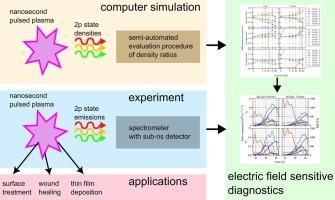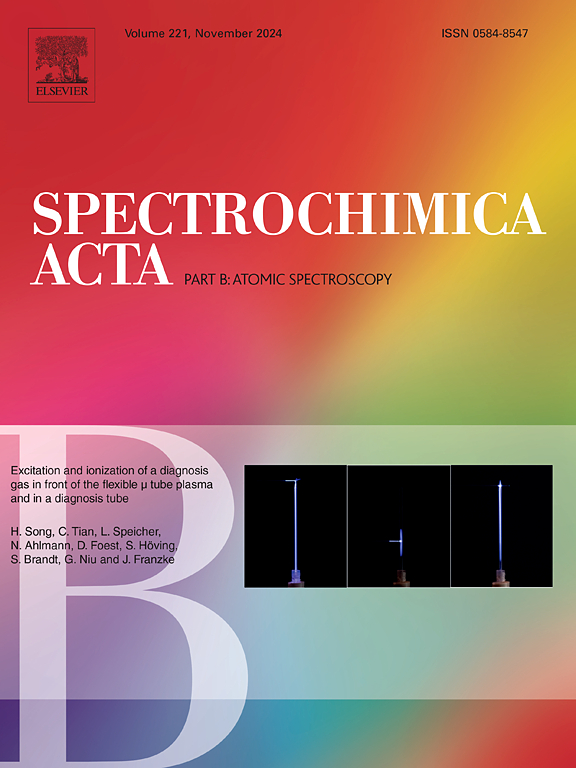Theoretical analysis of argon 2p states' density ratios for nanosecond plasma optical emission spectroscopy
IF 3.2
2区 化学
Q1 SPECTROSCOPY
引用次数: 0
Abstract
A theoretical analysis of excited argon state densities responsible for optical emission spectra of atmospheric pressure argon plasma is presented for its use in plasma diagnostics. Nanosecond pulsed barrier discharges are simulated using spatially one- and two-dimensional fluid-Poisson models using the reaction kinetics model presented by Stankov et al. [1], which considers all ten argon 2p states (Paschen notation) separately. The very first (single) discharge and repetitive discharges with frequencies from 5 kHz to 100 kHz are considered. A semi-automated procedure is utilized to find appropriate 2p states for electric field determination using an intensity ratio method, which is based on a time-dependent collisional-radiative model. The fluid simulations in combination with the semi-automated procedure are used to quantify the sensitivity of selected 2p-state ratios to given preionization of the gas. A highly sensitive time-correlated single photon counting experiment shows clearly that the selected ratio is sensitive to the electric field variation in the streamer head, yet additional calibration is needed for absolute values determination. Different approaches for effective lifetime determination are tested and applied also to measured data. The influence of radial and axial 2p state density integration on the intensity ratio method is discussed. The above mentioned models and procedures result in a flexible theory-based methodology applicable for development of new diagnostic techniques.

纳秒等离子体发射光谱中氩2p态密度比的理论分析
本文对常压氩等离子体发射光谱的激发氩态密度进行了理论分析,用于等离子体诊断。利用Stankov等人提出的反应动力学模型,利用空间一维和二维流体-泊松模型模拟纳秒脉冲势垒放电,该模型分别考虑了所有十种氩2p态(Paschen符号)。考虑了频率从5 kHz到100 kHz的第一次(单次)放电和重复放电。利用半自动化的程序,利用强度比法确定合适的2p态,该方法基于时间相关的碰撞辐射模型。流体模拟与半自动化程序相结合,用于量化所选2p态比对给定气体预电离的敏感性。高灵敏度的时间相关单光子计数实验表明,所选择的比值对流光头电场变化很敏感,但绝对值的确定需要额外的校准。对有效寿命测定的不同方法进行了测试,并将其应用于测量数据。讨论了径向和轴向2p态密度积分对强度比法的影响。上述模型和程序产生了一种灵活的基于理论的方法,适用于开发新的诊断技术。
本文章由计算机程序翻译,如有差异,请以英文原文为准。
求助全文
约1分钟内获得全文
求助全文
来源期刊
CiteScore
6.10
自引率
12.10%
发文量
173
审稿时长
81 days
期刊介绍:
Spectrochimica Acta Part B: Atomic Spectroscopy, is intended for the rapid publication of both original work and reviews in the following fields:
Atomic Emission (AES), Atomic Absorption (AAS) and Atomic Fluorescence (AFS) spectroscopy;
Mass Spectrometry (MS) for inorganic analysis covering Spark Source (SS-MS), Inductively Coupled Plasma (ICP-MS), Glow Discharge (GD-MS), and Secondary Ion Mass Spectrometry (SIMS).
Laser induced atomic spectroscopy for inorganic analysis, including non-linear optical laser spectroscopy, covering Laser Enhanced Ionization (LEI), Laser Induced Fluorescence (LIF), Resonance Ionization Spectroscopy (RIS) and Resonance Ionization Mass Spectrometry (RIMS); Laser Induced Breakdown Spectroscopy (LIBS); Cavity Ringdown Spectroscopy (CRDS), Laser Ablation Inductively Coupled Plasma Atomic Emission Spectroscopy (LA-ICP-AES) and Laser Ablation Inductively Coupled Plasma Mass Spectrometry (LA-ICP-MS).
X-ray spectrometry, X-ray Optics and Microanalysis, including X-ray fluorescence spectrometry (XRF) and related techniques, in particular Total-reflection X-ray Fluorescence Spectrometry (TXRF), and Synchrotron Radiation-excited Total reflection XRF (SR-TXRF).
Manuscripts dealing with (i) fundamentals, (ii) methodology development, (iii)instrumentation, and (iv) applications, can be submitted for publication.

 求助内容:
求助内容: 应助结果提醒方式:
应助结果提醒方式:


